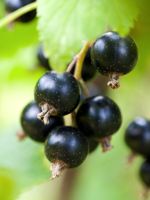Mon-Fri 9am - 5pm Mountain time
Grouseberry vs Ben Sarek Black Currant
Vaccinium scoparium
Ribes nigrum Ben Sarek
CUSTOM GROW
NOT AVAILABLE THIS SEASON - MIGHT RETURN
Grouseberry is a native, low-growing deciduous shrub known for its edible red berries. In early summer, it produces small, urn-shaped flowers ranging from white to pink that attract bees and other pollinators. The berries provide an important food source for many types of wildlife, including game birds such as grouse, which gives the plant its common name. People can also enjoy the berries fresh or in baked goods, though they can be difficult to harvest in large quantities.
Spreading by rhizomes, Grouseberry forms dense, broom-like mats that help stabilize soil and prevent erosion, while also providing cover for ground-nesting wildlife. It is commonly found beneath conifers in open forests, subalpine meadows, and occasionally on rocky slopes in mountainous regions. It is well-suited for naturalization, ecological restoration, and soil stabilization projects.
Ben Sarek Black Currant is a compact, high-yielding Black Currant cultivar, making it ideal for smaller gardens and easy berry picking. The large clusters of flavourful, sweet-tart berries ripen in mid-summer and are perfect for fresh eating, preserves, baked goods, and liqueurs. Plants may start producing some berries after two years, reaching full production in about four to five.
Developed by the Scottish Crop Research Institute, Ben Sarek Black Currant is resistant to powdery mildew and moderately resistant to white pine blister rust. It is self-fertile, meaning it does not require cross-pollination from another variety to produce fruit.

